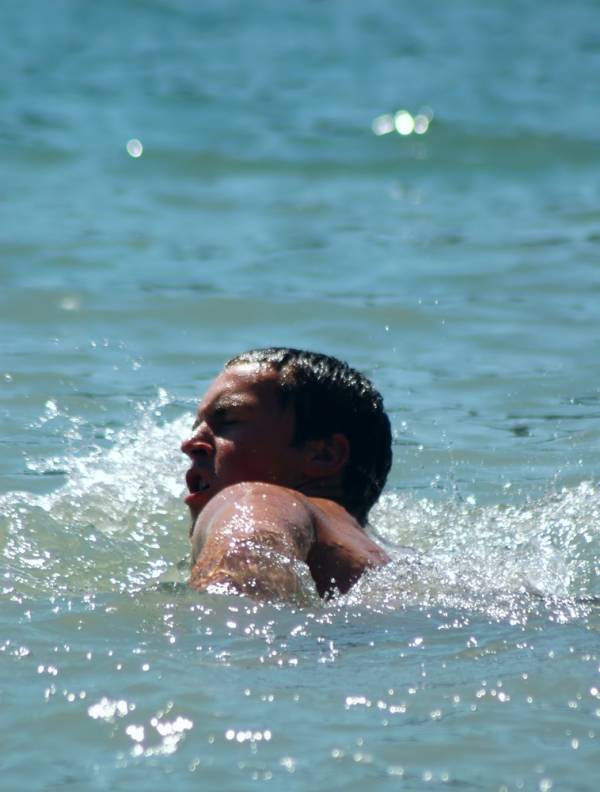Life wouldn’t exist without the sun, yet the sun presents a major challenge and a potential danger to open water swimmers, or anyone swimming outdoors. Sun damage comes in the form of over-exposure and sun blindness. Long periods of swimming combined with salt can also provoke the condition of chafing, which is never fun. Luckily these conditions can be simply remedied and more easily prevented in the first place.
However you look at it sun exposure is bad. In an aquatic environment the sunrays are amplified, potentiating the level of damage that can happen. There are two types of ultraviolet radiation from the sun, UVA and UVB. UVB rays are usually the culprit in sunburns. Some of the obvious common sense measures to prevent this damage include the use of sunscreen lotions. For open water it is recommended that an SPF40 or higher be used and applied every four hours.
To understand how sunscreen ratings work, remember that SPF relates to the filtration of the sunrays. For example an SPF15 filters out approximately 93% of UVB rays, SPF30 about 97%, and SPF50 approximately 98%. While it seems the differences in filtration is rather insignificant, depending on your sensitive and history of skin cancer the extra 1% can make a world of difference. Alternatively, swimmers can opt for sunblock like zinc oxide, that don’t require reapplication as frequently, but tends to be messier and not cosmetically appealing. Another alternative to sunblocks are sunblocking clothing or suits, which will provide a broad spectrum block of UVA and UVB radiation, but could make movement a little more restrictive.
But what if it is too late and your skin has already received some damage from the almighty sun? The first measure is avoid further exposure if possible, or avoid further injury by application of sunscreens and lubricants, including pure aloe and lanolin. If it is during an event and at the point of actual sun poisoning, the athlete should be removed from the competition and have topical steroids applied to the areas of skin affected, or in more extreme cases oral steroids may be recommended.
Another common issue encountered at events and during open water swimming is sun blinding. This happens due to the intensity of the sun and the reflection off the water as the swimmer is sighting. Sighting is a necessary evil in open water as there are no lines at the bottom to follow to the wall like in a pool. A swimmer that is inefficient at sighting may end up swimming a lot of unnecessary meters to make it to the same finish line as someone who is an efficient sighting swimmer. There is a very, very simple way to prevent sun blinding: use mirrored goggles.
 If you didn’t wear mirrored goggles and are suffering from sun blinding then you may feel burning in your eyes and experience tearing. The basic treatment for this condition is simple and consists of the application of liquid tears without preservatives. It is not a serious condition, and doesn’t usually lead to any complications. It is more bothersome and a nuisance, but very easily avoided and/or fixed.
If you didn’t wear mirrored goggles and are suffering from sun blinding then you may feel burning in your eyes and experience tearing. The basic treatment for this condition is simple and consists of the application of liquid tears without preservatives. It is not a serious condition, and doesn’t usually lead to any complications. It is more bothersome and a nuisance, but very easily avoided and/or fixed.
A second bothersome issue associated with open water swimming (or any swimming for long periods of time, for that matter) is chafing. Chafing is set up by prolonged exposure to salt, water, and the variable stroke patterns caused by wave action. It is a true laceration, prone to infections with all the complications associated with it. The most common sites for chafing in open water swimmers are the suit lines, shoulders (caused by the breathing patterns), armpit, inner thighs, and the back of the neck (from sighting). I believe when I swam the Maui channel relay I suffered from almost all of these. Mostly they can be prevented, or their severity diminished through preventative measures.
A simple application of lubricant, like lanolin, body glide, Vaseline, body balm, or any of the many others available will reduce or prevent chafing on most if not all the sites mentioned. This application should not be performed by the swimmer, but by a support person who can ensure the proper application in the correct places. If the chafing has already occurred, then the areas affected should be treated with topical antibiotics that have anti-Staph activity like Bactroban. Do not use Neosporin. Using further protection as described above will also help prevent further damage.
While these measures apply to open water swimmers, most of what I described about sun damage and chafing can easily be applied to the recreational swimmer or the average beach goer of any age. Prevention is the key, but if you failed at prevention hopefully these tips will help you find comfort through your predicament.
Photos courtesy of Shutterstock.






